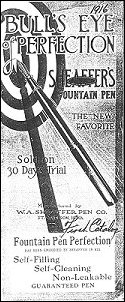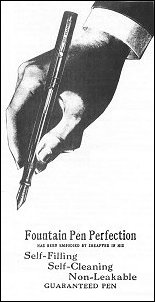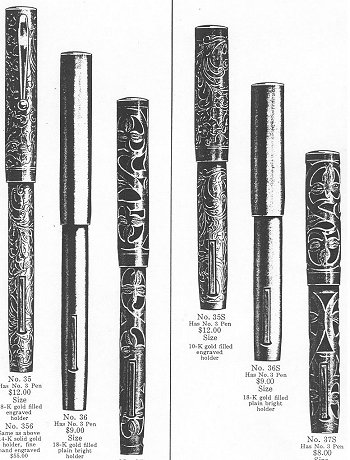By the unanimous testimony of all parties concerned, work on Sheaffer's first pen catalog began towards the end of 1912. The first batch, printed by the Schooley Stationery Co., was delivered towards the end of February 1913 (1757.677, 1760.680). Eventually some 10,000 of these catalogs were printed (769.459,1856.776). The total number of pages was twelve, sixteen if the cover was included (778.468). The number of pages exactly coincides with the page count of the Sheaffer archive catalog, as does the content, most notably the cutaway views showing the pre-1914 unsprung pressure bar (fig. 2). No mention is made of the double-bar mechanism, and the parts list is clearly for the early single-bar pens. The court records also cite a paragraph found in Sheaffer's first and second catalogs which is also found in the Sheaffer archive catalog (1002.692). As icing on the cake, the records include a Sheaffer letter of February 12, 1913 seeking copyright protection for "lever filler" and "bull's eye of perfection" (537.227) –-- the exact terms featured most prominently in the Sheaffer archive catalog.
Fig. 2: Sectional view of single bar pen, first Sheaffer catalog (note end piece and simple pressure bar). The same printers were responsible for the second catalog, which was issued around August or September 1914 (1857.777). This catalog was still current as of November 1915 (998.688), and according to the testimony was nearly identical to the first catalog. The most significant change noted was the updating of the cutaway views to show the newly-patented double-bar mechanism (997.687).
Fig. 3: Sectional view of double bar pen, second Sheaffer catalog. An example of this second catalog was published in the Pen Fancier's Magazine of August 1988 (pp. 6-13, there dated to 1916).The second catalog is pretty much identical to the Sheaffer archive catalog. The cutaway views have been updated (fig. 3) and the cover has been changed (fig. 4), eliminating the "bull's eye" imagery (also absent from Sheaffer's first national magazine advertisement, which appeared September 1914). If it weren't clear enough that this catalog was a patch-up job on the first catalog, the original parts list is unchanged, and still lists among the internal components the end piece, used only for the single-bar pen.
Fig. 4: Cover of second Sheaffer catalog, third quarter 1914 In fact, the court records explicitly state that the electrotype printing blocks used for the pen pictures of the first catalog were largely carried over to the second, and in some cases were still in use in 1915 at the time testimony was being taken (769.459, 862.552ff). It seems that obtaining electrotypes of high enough quality was expensive and problematical enough that new ones were not ordered lightly, even though the images still showed the early levers, which were wider and longer, and set so close to the end of the barrel that the lever could not be operated when the cap was posted. (774.464, 848.538) These levers are clearly identifiable in both the first and second catalogs, and it is worth remarking that two of the images from these catalogs (fig. 5) were used yet again in a still-later Sheaffer brochure in the Reference Library, there dated to c. 1916 (this time probably correctly). These two images are of overlay pens, which is absolutely consistent with Sheaffer's testimony about which electrotypes remained in use after 1914.
Fig. 5: Single-bar pens with overlays, plates used for first, second, and later catalogs. The redating of the first Sheaffer catalog raises other issues, of which only one will be addressed here. Some collectors have expressed doubts that Sheaffer produced overlay pens during their first few years of production. These doubts should now be laid to rest, as the catalog illustrates three full overlay designs: smooth, hand-engraved, and trefoil filigree. Walter A. Sheaffer also personally testified that the early single-bar lever-fillers had been offered at retail prices up to $55 (710.400) – more than twice the contemporary price of a Waterman 514 filigree in solid 14K gold. This should not be surprising given Sheaffer's background as a retail jeweler. In fact, the court testimony makes it clear that Sheaffer was selling a significantly greater variety ofpens than were listed in the early catalogs, including "fancy gold and silver mounted fountain pens" – though it must not be forgotten that "mounted" pens included those furnished with decorative metal bands as well as full overlays (779.469, 1817.737). In any event, Sheaffer himself left some intriguing commentary about such pens in the record, for upon being asked, "And new designs for such mountings were submitted by the manufacturers from time to time, were they not?" -- indicating that Sheaffer was not designing and commissioning overlays and trim, but instead selecting from the manufacturers' offerings -- Sheaffer accepted this assertion, and responded, "New designs were delivered from the manufacturers when ordered, but there was virtually no sale for fancy mounted pens until the fall of the year, or for Christmas trade. . . ." He went on to state that so few fancy pens were sold outside of the Christmas season that dealers typically would return their fancy pens after the holidays, exchanging them with the manufacturer for regular stock items (779.469). Sheaffer Sub-Brands:Sheaffer's success was founded on its lever-fillers, but from early on more economical pens were sold as well. The patent dispute testimony records that company policy was not to sell a lever pen for less than $2.50, but other self-fillers and eyedroppers were offered at $1 under other brand names (710.400). The main sub-brand was Craig, named after Walter Sheaffer's son and future heir (888.578); the other sub-brand mentioned in the testimony was University, which Julius Schnell described as a coin-filler (1970.890). Schnell appears to have been responsible for providing the holders for all of these early dollar pens. The nibs – #2 and #3 warranteds, judging from surviving specimens – came from George P. Gaydoul & Co. (1955.875), and the self-filling pens used a cheap off-the-shelf spring pressure-bar from the Duryea company (1906.826, 1961.881). Sheaffer's first dollar pens were produced some time after work had started on the single-bar lever-fillers, though not too much later, since on June 26, 1912, Kraker & Coulson (Sheaffer's original partners and distributors) were already passing along an order for nineteen dozen single-bar Sheaffer pens, three and a half dozen eyedropper-filling dollar pens, and three cards of clips (522.212). Sheaffer also testified that Craig pens were being made before November 1912 (888.578; 389.79, 701.391). Apparently all of the dollar pens were eyedroppers at first (824.514, 1906.826), coin-fillers being added to the line about a year later – unfortunately, the dates given by Sheaffer, Schnell, and Kraker in their testimony are often difficult to reconcile with exactitude (1906.826, 2006.926, 2008.928). Craig eyedroppers and coin-fillers are scarce, but a number of examples are now in collections, and there is even one retracting-nib safety Craig known – not a model mentioned in the patent dispute testimony. On the other hand, Schnell did mention in 1915 "a self-filler with a little hole in it. . . filled with a little plug that was fitted into the back end of the barrel", which Sheaffer had discontinued some time before (1970.890). I am unaware of any extant matchstick-filling Craigs, although it is possible that the pen Schnell mentioned bore other markings. Lever-filling Craigs appear not to have been produced until some time after the testimony of 1915, but they are the most commonly found today. Sheaffer continued to sell cheaper pens under the Craig name through the 1920s; most are small pens in black hard rubber, but examples in celluloid are also known, including a few in bright yellow. Copyright © 2001-2003, 2019 David Nishimura. All rights reserved |





